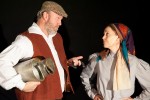Arne Larsen as Tevye and Ruth Kult as Golde in Gallery 7 Theatre’s production of Fiddler on the Roof. (photo by Dianna Lewis)
Growing up in a Jewish home, I always cherished Fiddler on the Roof and its Sholem Aleichem inspiration. I had a copy of the film in the entertainment room, but the recent Gallery 7 Theatre production was only the second time I have seen this classic as a live play, the first time being in high school.
Gallery 7 did an amazing job highlighting Jewish culture and tradition to audiences last month in Abbotsford, an area that is sparsely Jewish. The company’s executive and artistic director, Ken Hildebrandt, noted that all of the artists and technicians pursued the project with the utmost “passion, dedication and love,” and it showed.
Set in the fictional shtetl of Anatevka in czarist Russia, the musical’s subject matter isn’t for the faint-hearted. Tevye, Golde, their daughters and the other villagers experience the trauma of pogroms, the beauty of love and the strength of faith, offering lessons relevant to us even now.
What word best describes the play? Triumph. Triumph over poverty (the daughters married who they wish despite the lack of dowry) and adversity (antisemitism), and the triumph of women (including in the cast, as the fiddler was played by Abigail Curwen) and tradition (adapting to modernity).
Tevye is played with realism by Arne Larsen. Outside of the occasional accent slip, Larsen plays the role as if he were living in czarist Russia himself. He sings with honesty, and truly seems to wrestle with the Divine to honor his faith. Tevye is the papa, the one to be obeyed, but, as the play develops, he shows a remarkable love for his daughters, allowing them to marry who they wish – as long as they are Jewish. Even in the case of Chava (Anastasia McIntosh), who is “dead to him” because she marries Sasha (Sheldon Jeans), a non-Jew, Tevye wishes, “May G-d be with you.” Then there is Perchik (Kevin Hegeman), who turns everything into a political statement. At one point, he compares the biblical Laban to a modern employer in the socialist sense, one of the play’s many comedic moments.
The shtetl world was brought to life by the costume and set design of Rafaella Rabinovich, who has a BA from the Rafeket Levy Design School for the Performing Arts in Tel Aviv. She told the Independent that it was both a great privilege and a wonderful challenge to put together. (For a profile of Rabinovich, see the article “Relishing theatre life.”)
The play’s one main set, simple by theatre standards, was a very colorful depiction of a village house. The costumes accented some of the characters’ meanings. For example, the police outfits were distinguished for their detail and, when they appeared, one knew trouble was to follow. Tevye was costumed with tzizit and hat, which was used to great purpose at the end of the play when he notes that perhaps Jews wear hats because they are forced to move so often.
The rabbi in the play, however, more resembled a modern non-Orthodox rabbi in appearance with his clean shave and, at one point, he is caught drinking rather than praying. This bit of artistic licence contributed to Walt Derksen’s performance seeming less believable from a historical perspective. The play could have also used more attention to lighting.
While it wasn’t Broadway, Gallery 7’s Fiddler was a believable drama about triumph over adversity, and the strength of love. Many audience members were visibly moved. And, for this reviewer at least, the play brought a little welcome Yiddishkeit to his neighborhood.
Gil Lavie is a freelance correspondent, with articles published in the Jerusalem Post, Shalom Toronto and Tazpit News Agency. He has a master’s of global affairs from the Munk School of Global Affairs at the University of Toronto.


I saw the play first in Buenos Aires as a teenager, over 4 decades ago. A peculiar aspect of that production was that at the end, when everybody is saying good bye and departing to distant lands, in that production, instead of New York and Chicago, someone went to Buenos Aires, “to live with a relative who cannot stand”, while another went to colonize the Pampas, as my ancestors did at the end or the 19th century. They adapted the script to the local audience and give it a connection with the present. In this production, all went to the US, except for the matchmaker who went to Palestine. Wouldn’t be nice in a future production to add a Canadian touch? Instead of Buenos Aires, or Chicago, or New York, we could easily mention Winnipeg or Montreal, and there is no lack of Jewish settlements in the Prairies that we could celebrate and remember, like New Jerusalem, Wapella, Hirsch Colony, Edenbridge, etc. All in all, we enjoyed the evening very much, very emotive at times.